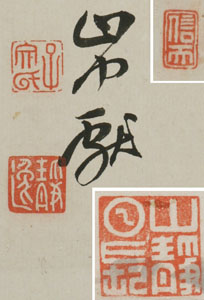Nanga
Mountain landscapeSigned: Yamanaka Ken
Seals: Azana wa Bunshi, Seiitsu, Shinten (top), Yama shizuka nishite hi nagashi (The mountain is quiet and the day is long (bottom)
Technique: sumi on paper 138,7 x 31,4
Mounting: grey damask 202 x 44,4
Box: authorized in the winter of 1911 by Tenrai (..)
Condition: waterstain at the top of the mounting, otherwise very good
The poem reads: 雲陽道士家在最高「山松」鶴 影通頭上一聲響碧天
”Clouds have gone and it gets warm
The hermits house at the highest peak
The shadow of a crane passes
and it shouts its sound into the blue sky.”
Shinten'ô (Seiitsu) was one of the key figures in the Kyoto literati world.
He was born into a well-to-do and rather intellectual farming family near Nagoya. He studied calligraphy with Shinozaki Shôchiku (1781-1851), but as a painter he seems to have been mainly self-taught.
After his father’s death in 1848 he had to prolong his studies at the local temple school. When his younger brother died his uncle sponsored his Confucian studies with Saitô Setsudô (1792-1865) for three years. Thereafter he studied Chinese literature with Yanagawa Seigan (1781-1859) and Umeda Unpin (1825-1865). Here he met with the loyalists Rai Miisaburô and Fujimoto Tesseki (1817-1863) and they became friends. To avoid charges from the Bakufu he started to travel.
As a former member of the anti-Bakufu Imperial Loyalist movement, he received important governmental posts after the Meiji restoration, but, not yet fifty years old, he retired to devote his time to art and literati gatherings in his luxurious villa in Arashima.
Reference:
Addiss 1993
Kato 1998 1st chapter (# 139 - 147)
Berry '01 p. 157-159
Hempel '98 pp. 169-170
Araki p. 1357
Price: SOLD

